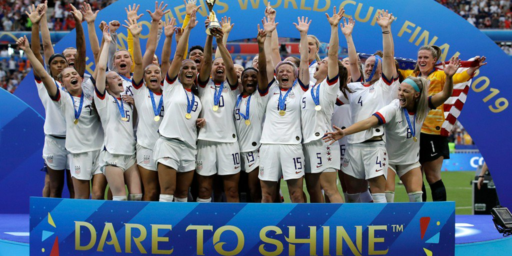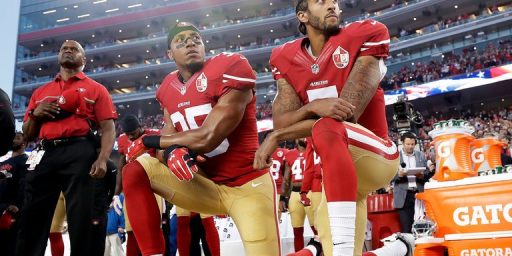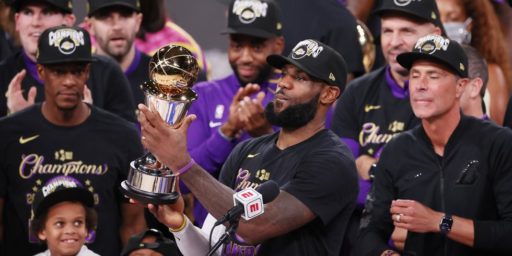Home Court Advantage Quantified
Matthew Yglesias observes,
Here in Round 2 of the NBA playoffs we’re seeing once again that home court advantage matters a lot — out of eight total games, seven have been won by the home team. Which makes me wonder — is anyone aware of any good research on what the home court advantage consists of? Why should it be so strong?
I’m not sure I’d draw a lot of conclusions from eight games in the second round of the playoffs in a single year. But, yes, as it happens, such research exists.
A recent article in the Journal of Quantitative Analysis in Sports, “The Role of Rest in the NBA Home-Court Advantage,” attributes the difference to fatigue differentials. Phil Birnbaum summarizes the study and findings in some detail. Essentially, teams do worse in back-to-back games and home teams have fewer of those and are thus more rested. The study authors have a large N: all the NBA games from two seasons. It’s unclear that this would apply to the playoffs, though, since both teams have roughly the same travel schedule.
A 2007 study published in the the same journal, “Home Advantage in the NBA as a Game-Long Process,” found that the advantage applied earlier in games and diminished as the games went on. Looking at all games over two NBA seasons, the researchers found, “In both years studied the home team accumulated two thirds of the home advantage it had at the end of the game in the first quarter. It accumulated less of an advantage in the second and third quarters, and still less in the fourth quarter.”
An article in Journal of Sport Behavior from eight years ago, “Athletes’ Perceptions of the Home Advantage: An Investigation of Perceived Causal Factors” studied home-court advantage for college basketball players. The study was based on athlete questionnaires rather than external factors. It found, “Athletes reported familiarity with the home court, the home crowd, and travel demands were important game location factors. Familiarity with the home court and home crowd support were perceived to have had the greatest influence on team performance.” Whether these perceptions are more than conventional wisdom is unclear — and all I have to go on is a brief extract. It stands to reason, though, that even if those factors aren’t as strong as players believe them to be, the mere perception would have an impact.
So, the answer to Matt’s question is Yes, the question has been studied but, No, we don’t really know the answer.






A few thoughts to try and help explain it. Home teams are, well, at home. This means they get to sleep in their own beds, don’t have as much time lost in transit, eating, etc.
Home team dressing rooms tend to be a little better than road team dressing rooms. Every little bit counts.
While the dimensions of the court (or field in other sports) may nominally be the same, it is a mistake to think that they are not unique in ways which can’t be seen on TV or sometimes even from the stands. Larry Bird once spoke on the dead spots in the floor on Boston Garden and making sure he knew where they were both for offensive and defensive purposes. Some football fields are notorious for bad spots that are better known to the home teams than the road teams.
And finally, of course, there is the crowd. The crowd doesn’t always make much of a difference, or shouldn’t when we are talking about professionals, but it has to be easier to do something difficult when ten of thousands of people are supporting you rather than booing, cursing, and yelling at you. While officials are neutral, it is within the realm of belief to imagine that they are at times subconsciously influenced by the crowds.
Here’s another theory:
Every outside shooter has his “spots”. Spots are places he practices his shots over and over. A shooter tries to get to his spots for shots as much as possible.
An NBA team plays 1/2 of its games and takes most of its practices on its home court. The shooters’ spots are consistent there and most of the practice shots are taken there.
In the playoffs, for most of the teams, only a small percentage of games and practices have been played on the “away” court during the season. Consequently, the outside shooters are at a relatively greater disadvantage when they are away. I suspect shooting outside of 15′ is not nearly as consistent for away teams. (Someone with better access than I have to the statistics might check that out.)
Even great offensive rebounding is unlikely to make up for that difference.